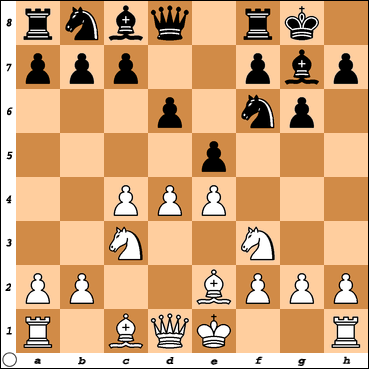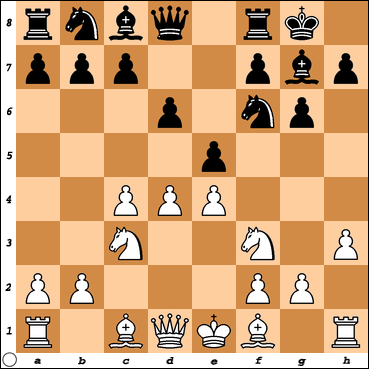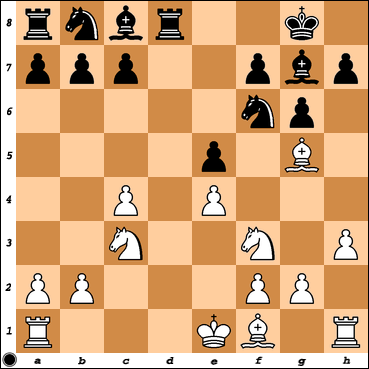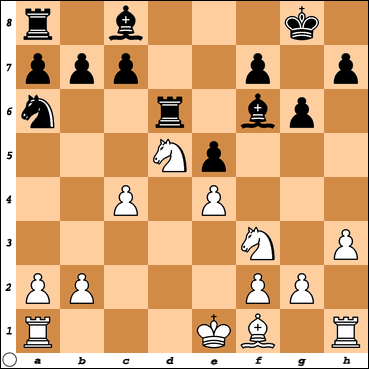NSWCA InterClub Grade Matches 2009 and KID exchange [edited]
I was at the Club last evening as captain of the U1400 Ryde Eastwood Mates team playing manly B. We won 3-1.
The U1800 team was also playing and I saw a bit of the opening in the game on Bd 1 where our Brenton Yum was playing black. The game turned into a KID where White decided to liquidate the Queens. I am not sure what was the result as I left before the game finished. I was reading Chessbase and came across this opening survey they published in the Chessbase magazine, "Fighting and winning against a drawish line" by GM Dejan Bojkov. The games look very similar and I thought may be helpful to Club members. Note: In the Brenton Yum's game, I don't think White played h3 before exchanging Queens. So the theory may be slightly different. [Edit (01/07/09): But Gallagher in SO:KID book is very dismissive of this extra move 6 h3 saying "[t]he fact White has played h2-h3 instead of Be2 hardly makes any difference". Note that h3-move is aimed at palying Be3 without having to worry about B's Ng4. It is also aimed at the aggresive advance of g2-g4 (to gain space and dissuade B from playing f7-f5).]
[Edit (01/07/09): I went back to my books and had a further look. In the normal KID Exchange Var, both players have reached the following position in Classical KID (1 d4 Nf6 2 c4 g6 3 Nc3 Bg7 4 e4 d6 5 Nf3 0-0 6 Be2 e5):

Here, the most popular move, if White wishes to continue with Classical KID is 7 0-0. However, White can opt for the Exchange Var with 7 dxe5 dxe5 8 Qxd8 Rxd8 and we reach a queenless middlegame. White can use this Var to draw with 9 Nd5 Nxd5 10 cxd5 c6 11 Bc4 cxd5 12 Bxd5 Na6 13 Bg5 Re8 14 0-0-0 Nc7 15 Bb3 Be6 =.
In Brenton's game I think his opponent played 9 Bg5 which complicates especially if Black plays 9...c6!? [Khalifman]. W has weakness on d4-sq and has to play: 10 Nxe5 Re8 11 0-0-0 Na6. B has excellent compensation for pawn in the form of active piece play.
Alternatively, B can play: 9...Re8 [Fischer's line and Gallagher's recommendation in SO:KID book]10 Nd5 (10 0-0-0 h6 (10...Na6) 11 Be3 c6 12 Ne1 Be6 13 Nc2 Bf6 14 f3 a6!? 15 Rd2 b5 16 b3 Nbd7 17 Rhd1 Rec8 =/+) 10...Nxd5 11 cxd5 c6! [B doesn't want weak oawn on open file] 12 Bc4 (12 d6?! [leaving isolated pawn in enemy camp]) 12...cxd5 13 Bxd5 Nd7!. Here, Gallagher gives two games and the first is Salgado-Gallagher L Hospitalet 1992 and the second is
Note: 9 Nxe5 is not good after 9...Nxe4! 10 Nxe4 Bxe5 and B has active pieces, d4-sq is a nice outpost, and better game after 11 Bg5 Rd4! (11 0-0 Nc6).]
I reproduce an extract (click on games to replay with further annotations and more games in original article):
The U1800 team was also playing and I saw a bit of the opening in the game on Bd 1 where our Brenton Yum was playing black. The game turned into a KID where White decided to liquidate the Queens. I am not sure what was the result as I left before the game finished. I was reading Chessbase and came across this opening survey they published in the Chessbase magazine, "Fighting and winning against a drawish line" by GM Dejan Bojkov. The games look very similar and I thought may be helpful to Club members. Note: In the Brenton Yum's game, I don't think White played h3 before exchanging Queens. So the theory may be slightly different. [Edit (01/07/09): But Gallagher in SO:KID book is very dismissive of this extra move 6 h3 saying "[t]he fact White has played h2-h3 instead of Be2 hardly makes any difference". Note that h3-move is aimed at palying Be3 without having to worry about B's Ng4. It is also aimed at the aggresive advance of g2-g4 (to gain space and dissuade B from playing f7-f5).]
[Edit (01/07/09): I went back to my books and had a further look. In the normal KID Exchange Var, both players have reached the following position in Classical KID (1 d4 Nf6 2 c4 g6 3 Nc3 Bg7 4 e4 d6 5 Nf3 0-0 6 Be2 e5):

Here, the most popular move, if White wishes to continue with Classical KID is 7 0-0. However, White can opt for the Exchange Var with 7 dxe5 dxe5 8 Qxd8 Rxd8 and we reach a queenless middlegame. White can use this Var to draw with 9 Nd5 Nxd5 10 cxd5 c6 11 Bc4 cxd5 12 Bxd5 Na6 13 Bg5 Re8 14 0-0-0 Nc7 15 Bb3 Be6 =.
In Brenton's game I think his opponent played 9 Bg5 which complicates especially if Black plays 9...c6!? [Khalifman]. W has weakness on d4-sq and has to play: 10 Nxe5 Re8 11 0-0-0 Na6. B has excellent compensation for pawn in the form of active piece play.
Alternatively, B can play: 9...Re8 [Fischer's line and Gallagher's recommendation in SO:KID book]10 Nd5 (10 0-0-0 h6 (10...Na6) 11 Be3 c6 12 Ne1 Be6 13 Nc2 Bf6 14 f3 a6!? 15 Rd2 b5 16 b3 Nbd7 17 Rhd1 Rec8 =/+) 10...Nxd5 11 cxd5 c6! [B doesn't want weak oawn on open file] 12 Bc4 (12 d6?! [leaving isolated pawn in enemy camp]) 12...cxd5 13 Bxd5 Nd7!. Here, Gallagher gives two games and the first is Salgado-Gallagher L Hospitalet 1992 and the second is
Note: 9 Nxe5 is not good after 9...Nxe4! 10 Nxe4 Bxe5 and B has active pieces, d4-sq is a nice outpost, and better game after 11 Bg5 Rd4! (11 0-0 Nc6).]
I reproduce an extract (click on games to replay with further annotations and more games in original article):
"The King's Indian Defence is exceptionally fashionable nowadays. Many more players include it in their repertoires in order to fight for more than a draw with the black pieces. In the recently ended super-tournament in Linares 7 out of 56 games saw the KID and the second player managed to achieve a positive score. Moreover, Black lost none of them. In order to find a safe weapon against this aggressive opening White tries to restrict the possibilities of the second player as early as possible.
"In the positional line 1.d4 Nf6 2.c4 g6 3.Nc3 Bg7 4.e4 d6 5.Nf3 0-0 6.h3 e5
"White recently tried to fight for an opening advantage in a simple way, swapping the queens by 7.dxe5 dxe5 8.Qxd8 Rxd8 9.Bg5
"Against this I recommend to you a reciprocal approach - development:
9...Na6 10.Nd5 Rd6 11.Bxf6
(For the rare 11.Nd2 with the idea of gaining the two bishops see the game Urzica,A - Munteanu,A 1-0)
11…Bxf6
"I had to face this position twice at the Bulgarian Individual Championship in Blagoevgrad that ended at the end of February, and I cannot complain about the results. White's general plan is to advance the pawns on the queen's flank to grab space, and try to break the pawn formation of his opponent there with Bxa6. In doing so, he will also be happy to exchange one of the opponent's bishops. He may also try to seal the queen's flank and paralyse the pieces there.
"White can push forward the pawns in three ways:
"A) The direct approach 12.b4 weakens the long diagonal.
[......]
"B) The second approach is connected with long castling - 12.0-0-0 -, and only then the pawn advance.
[......]
"C) Finally, we reach the main line 12.Rc1.
The rook runs away from the pin and helps the pawns to advance. Against this Black can try 12…b6, a move that was highly praised by the leading specialist for White in the line, GM Grivas - see the game Arnaudov,G - Bojkov,D ½-½.
"I believe that even stronger is the modest move 12…Bd8.
"The bishop runs away from the exchange and can be very valuable in the coming battle. For the dangers that Black may experience when his queen's flank is broken see Arnaudov,P - Urukalovic,R 1-0. However, Black is doing fine if he manages to keep the pawns intact: Kapnisis,S - Kotronias,V ½-½, Kukov,V - Bojkov,D 0-1.
"Conclusion: Currently Black is doing fine in the exchange line of the KID with 6.h3. The exchange of the queens does not promise much, and it is recommendable for the first player to look for more complex play.






Comments